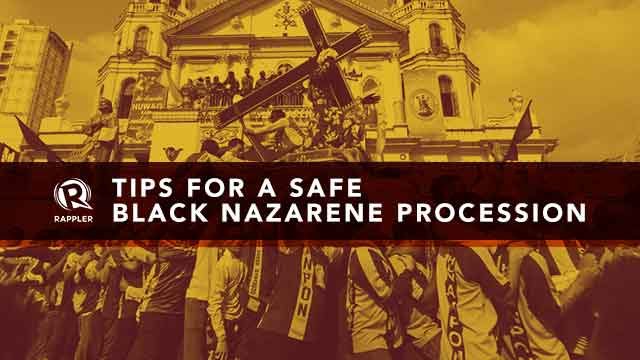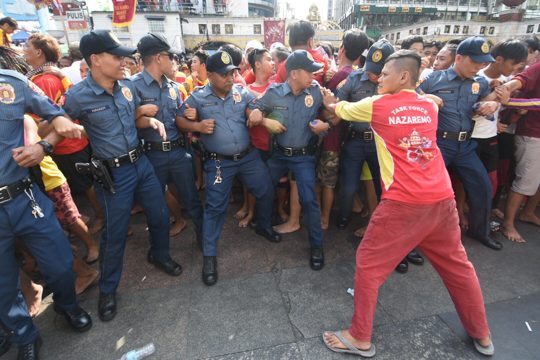SUMMARY
This is AI generated summarization, which may have errors. For context, always refer to the full article.

MANILA, Philippines – Every year, millions of devotees join the procession for the Feast of the Black Nazarene, where the image of a dark-skinned Jesus Christ believed to grant prayers will be brought from the Quirino Grandstand to the Quiapo Church.
In 2018, authorities estimate at least 18 million people will join the procession and other activities set for the second week of January. The procession is on Tuesday, January 9.
The efforts of millions of believers to touch the image of the Black Nazarene or get close to the carriage holding it could lead to unruly or even dangerous situations.
Rappler lists down safety tips to remember provided by the Philippine National Police (PNP) National Capital Region Police Office (NCRPO) for devotees joining the procession:
1. Secure your home.
For those leaving their homes unoccupied, cops advise double-checking appliances that may overheat and trigger fires if left on.
Devotees should also ensure their homes have sturdy locks to prevent robberies while they attend the long procession. In 2017, the procession lasted for more than 20 hours.
2. Join only if you are physically prepared.
The procession is not for everyone. Some devotees faint from exhaustion or fall ill because of the suffocating crowd and the scorching Manila weather.
Cops advise children, the elderly, pregnant women, and sick persons to say their prayers at home instead.
3. Only wear and bring what you need.
Devotees can get rowdy especially when the image approaches. Cops advise people to wear comfortable clothing they can easily move around in.
Valuables like wallets and mobile phones should also be brought with caution, since the PNP records the highest theft rates in crowded places. Though the Feast of the Black Nazarene is a religious celebration, it is not an exception.
4. No alcoholic drinks and guns.
Manila has imposed a liquor ban on January 9 to prevent intoxicated people from joining the procession and possibly causing a disturbance.
Police will also implement a gun ban from January 8 to 10 in the city.

5. Bring snacks and water.
To prevent fainting incidents brought by exhaustion and dehydration, devotees should bring food and drinks with them, or at least bring money to buy these necessities on site.
6. Keep your distance.
As soon as the image of the Black Nazarene appears within eyesight, many devotees scramble to get close to it. Participants are advised to be conscious of the crowds’ movement and to keep their distance if they want to avoid getting pulled in.
7. Have entrance and exit plans.
Instead of just simply hoping to reach the image of the Black Nazarene, devotees are urged to learn how to climb up and down the carriage and then find their way out of the sea of people.
8. Know how to reach authorities for help.
The PNP will have tents for those who would need medical attention or other assistance, while volunteer organizations like the Philippine Red Cross will also be deploying first aid personnel.
Keep the following hotlines handy as well:
- PNP Emergency – 911
- NCRPO – (02) 838-3203
- Manila Police District – (02) 523-1367
- NDRRMC Metro Manila – (02) 421-1918
– Rappler.com
Add a comment
How does this make you feel?
There are no comments yet. Add your comment to start the conversation.